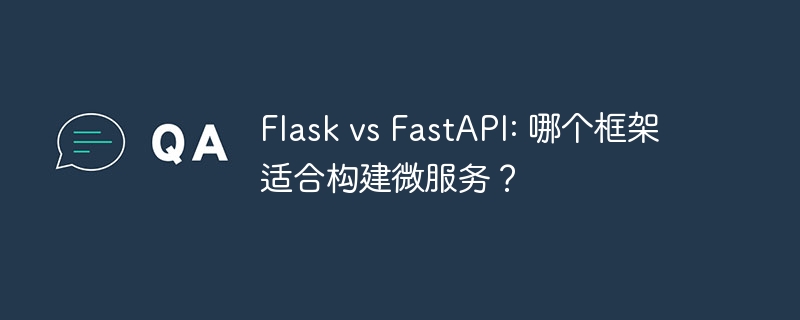Home >Backend Development >Python Tutorial >Flask vs FastAPI: Which framework is suitable for building microservices?
Flask vs FastAPI: Which framework is suitable for building microservices?
- PHPzOriginal
- 2023-09-28 11:15:331070browse

Flask vs. FastAPI: Which framework is suitable for building microservices?
Introduction:
Microservice architecture has become a hot topic in modern application development. When building microservices, choosing the right framework is critical to the success of the project. In this article, we will compare two popular frameworks, Flask and FastAPI, to see their capabilities and performance for building microservices.
- Introduction to Flask:
Flask is a lightweight web framework and one of the most popular frameworks in Python. It provides a simple and flexible way to build web applications. It is designed to allow developers to get started quickly and not limit their options. Flask's many extensions provide various functions and tools to make the development process more efficient and concise. - Introduction to FastAPI:
FastAPI is a new Python-based web framework that provides a high-performance way to build APIs. FastAPI uses a new generation of Python asynchronous framework Starlette to achieve high performance and concurrent processing. It follows the OpenAPI and JSON Schema specifications, and provides the function of automatically generating documents and client code. FastAPI is designed to provide a reliable and efficient development experience. - Function comparison:
In terms of functionality, both frameworks provide basic functions such as routing, request processing, middleware, and test support. However, FastAPI has advantages in some specific aspects. For example, FastAPI provides the function of automatically generating interface documents and client code, which is very helpful for developers and teams. In addition, FastAPI also supports asynchronous processing, making it possible to process multiple requests at the same time. - Performance comparison:
In terms of performance, FastAPI performs well. Because it uses asynchronous processing, it can handle more concurrent requests and has lower latency. Compared with Flask, FastAPI has better performance when handling a large number of concurrent requests. This is crucial when building microservices, where services often need to handle a large number of requests simultaneously.
The following is a sample code to build a microservice using Flask:
from flask import Flask, request
app = Flask(__name__)
@app.route('/api/example', methods=['POST'])
def example():
data = request.get_json()
# 处理请求并返回响应
return {'result': 'success'}
if __name__ == '__main__':
app.run()The following is a sample code to build the same microservice using FastAPI:
from fastapi import FastAPI
app = FastAPI()
@app.post('/api/example')
async def example():
data = await request.json()
# 处理请求并返回响应
return {'result': 'success'}
if __name__ == '__main__':
import uvicorn
uvicorn.run(app, host='0.0.0.0', port=8000)From the above As can be seen from the sample code, FastAPI is more modern and intuitive in syntax. It uses the async and await keywords to support asynchronous processing, making the code more concise and easier to understand.
Conclusion:
Choosing the right framework is one of the key decisions in building microservices. Choosing between Flask and FastAPI depends on the specific requirements of your project. If you value features such as performance, concurrency processing, and document generation, FastAPI may be a better choice. However, if flexibility and community support are more important for your project, Flask is also a great choice. Ultimately, you should make decisions based on project needs and team skills. No matter which framework you choose, you can quickly build efficient and reliable microservices.
The above is the detailed content of Flask vs FastAPI: Which framework is suitable for building microservices?. For more information, please follow other related articles on the PHP Chinese website!

